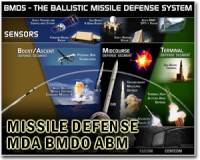| . |  |
. |
Abu Dhabi, United Arab Emirates (UPI) Dec 7, 2010 The United Arab Emirates is reported to be strengthening its missile defense network and plans to integrate it with other Arab states in the Persian Gulf to counter Iran's missile might. Experience shows that is unlikely to happen anytime soon. But even so, the emirates ordered four batteries of U.S. Raytheon Patriot MIM-104 PAC 3 air-defense missiles worth $3.3 billion in 2008. In September, the U.S. Congress cleared the sale of three Terminal High Altitude Area Defense anti-ballistic missile systems produced by Lockheed Martin Space Systems. Other key contractors are Boeing, Raytheon and Honeywell. THAAD is designed to intercept and destroy short-, medium- and intermediate-range ballistic missiles such as the Soviet-era Scud, up to Iran's Shehab-3b weapon that currently constitutes Tehran's strategic missile force. The THAAD deal could be worth up to $7 billion. The emirates, which are at odds with Iran over its occupation of three strategic islands in the gulf, would be the first regional state to be armed with THAAD. Kuwait and Saudi Arabia are also looking to upgrade their Patriot PAC 2 systems to PAC 3 standard. These contracts form part of an overall package of U.S. arms to gulf Arab states that totals some $122 billion over the next decade. Saudi Arabia alone will get arms worth $67 billion, the largest arms contract ever concluded by the United States. Senior emirates officials at a defense conference in Abu Dhabi, the emirates' capital and primary arms buyer, reported last week that it is setting up an integrated air and missile defense center. This, they said, could be a template for a gulf-wide missile defense system embracing the other member states of the Gulf Cooperation Council, Saudi Arabia, Kuwait, Oman, Qatar and Bahrain. "Other gulf states are thinking about THAAD," a defense source observed. "An integrated missile defense system is the best way to counter any threat." But the concept of a unified GCC defense system has been kicking around for more than 15 years and, despite lackluster efforts by individual states to establish their own systems, there has been little or no close military coordination or cooperation in this regard. Age-old tribal rivalries between the royal families that rule the GCC states have been a major stumbling block. The smaller gulf states are all wary of -- if not downright opposed to -- domination by Saudi Arabia, the leading state in the alliance and the world's largest oil exporter. One Persian Gulf official said the original GCC-approved plan for an integrated missile defense network involved a system that covered the Arabian Peninsula, extending a footprint from the southern Mediterranean to beyond the gulf, in conjunction with the region's Western allies. But analysts say that even though the perceived threat from Iran has grown as it allegedly seeks to acquire nuclear weapons, the prospect of a gulf-wide defense system, if it's anywhere, is years away. Despite the hundreds of billions of dollars these states have spent on Western arms over the last three decades, "the problem is that there isn't a GCC military alliance akin to NATO," said Mark Thomas of the Royal United Services Institute in London. Whether the burgeoning threat from Iran as perceived by Arab gulf leaders will change attitudes on this is far from certain. It is clear that none of the individual regimes in place is inclined to relinquish national control over their military forces. That attitude is best exemplified in the continued absence of an effective rapid deployment force, as was evident when Saddam Hussein invaded Kuwait in August 1990. Even the loss of Kuwait, albeit for only a few months, didn't prod the GCC states into forming a unified force of any size to handle such emergencies. There is a 9,000-man GCC force but it's little more than a token force without any real firepower. The council's military leaders agreed in 2008 to restructure the force and more than double its strength but a lack of political will and the inability of these states to work together meant the project foundered. The Saudis, for instance, have chosen to concentrate on building a 35,000-strong force to protect the kingdom's all-important oil installations, terminals and pipelines, as well as other essential infrastructure.
Share This Article With Planet Earth
Related Links Learn about missile defense at SpaceWar.com Learn about nuclear weapons doctrine and defense at SpaceWar.com All about missiles at SpaceWar.com Learn about the Superpowers of the 21st Century at SpaceWar.com
 Poland asked US about missile shield uses: WikiLeaks
Poland asked US about missile shield uses: WikiLeaksLondon (AFP) Dec 7, 2010 The US told Poland that a proposed American and NATO missile shield aimed at defending against attacks from Iran or Syria could be used to stop "missiles coming from elsewhere," US cables released by WikiLeaks showed Tuesday. Despite repeated claims that the shield is not aimed at deterring attacks from Russia, the correspondence suggests US officials have considered broader uses for the def ... read more |
|
| The content herein, unless otherwise known to be public domain, are Copyright 1995-2010 - SpaceDaily. AFP and UPI Wire Stories are copyright Agence France-Presse and United Press International. ESA Portal Reports are copyright European Space Agency. All NASA sourced material is public domain. Additional copyrights may apply in whole or part to other bona fide parties. Advertising does not imply endorsement,agreement or approval of any opinions, statements or information provided by SpaceDaily on any Web page published or hosted by SpaceDaily. Privacy Statement |